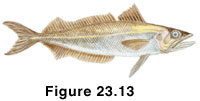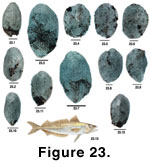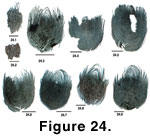 Description
DescriptionMerluccius productus
(Pacific Hake or Pacific Whiting)
(Other common names: Pacific Whiting, California Hake)
Figure 23.13
 Description
DescriptionLength: 90 cm.
Mouth: large, terminal; directed slightly upwards; lower jaw protrudes; maxillary extends to below pupil; teeth strong in bands in jaws and vomer.
Body: elongate; snout long; two dorsal fins; second dorsal long and notched; one anal long and notched caudal peduncle slender; caudal fin truncate; chin barbel absent; lateral line decurved then straight.
Color: silvery gray with black speckles on dorsal; silver below; brown on pectoral fins; black inside mouth and on the inside of the gill covers.
Depth: surface to 900 m; diurnal vertical migrations.
Habitat: generally offshore; benthic on sandy/muddy substrate.
Season: spawn in spring; eggs take three days to hatch.
Diet: euphasiids, sand lance, herring, anchovy, shrimp; feeds nocturnally
Predators: sharks.
Distribution: Gulf of California to Gulf of Alaska; in BC in intermediate water layers.
 Scale
Description
Scale
DescriptionRelative Scale Size: moderate to large.
Position of Scales on Body: along lateral line; 147-166; scales are deciduous.
Overall Shape: oval; this cycloid scale is distinctly different from the Gadidae
Focus and Circuli: the focus is not centralized between the four fields and is slightly more than one-third the total length from the anterior margin. The focus and the circuli are somewhat ovoid along the anterior-posterior axis. The circuli are continuous and can appear in a crenulated pattern. In mounted material, desiccation cracks can appear.
Radii: there are no radii and no distinct intermarkings.
 Scale
Preservation
Scale
PreservationLike scales of the closely related species in the Gadidae, these scales are found preserved, but are often not entirely intact. They are quite brittle and easily subject to erosion, cracking, or breaking, often at the leading edges. There is often also a tendency for them to break along a circuli. This results in central portions "popping" out from the leading edges. Merluccidae have distinct scales, and this is the only species in British Columbia waters making identification easy. Tallying should be made on the basis of the presence of a focus.